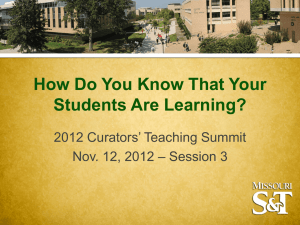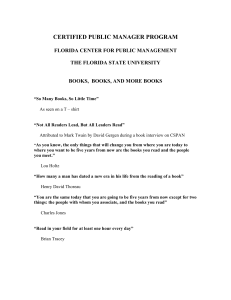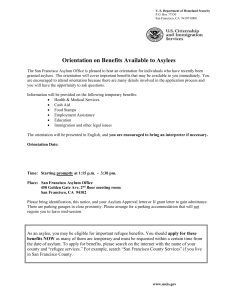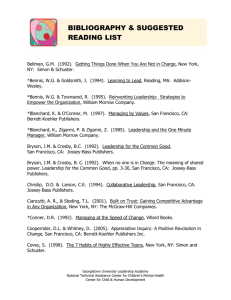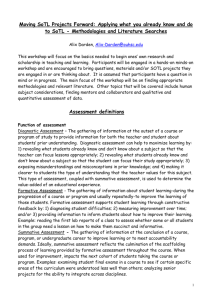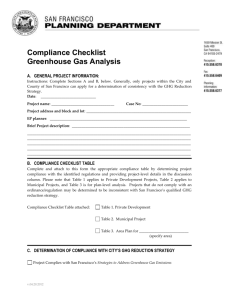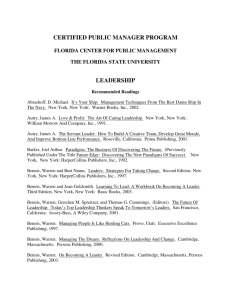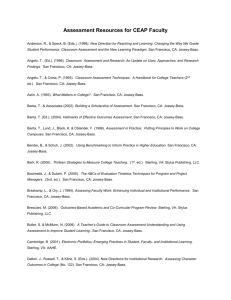Co-Creating Psychological Safety
advertisement
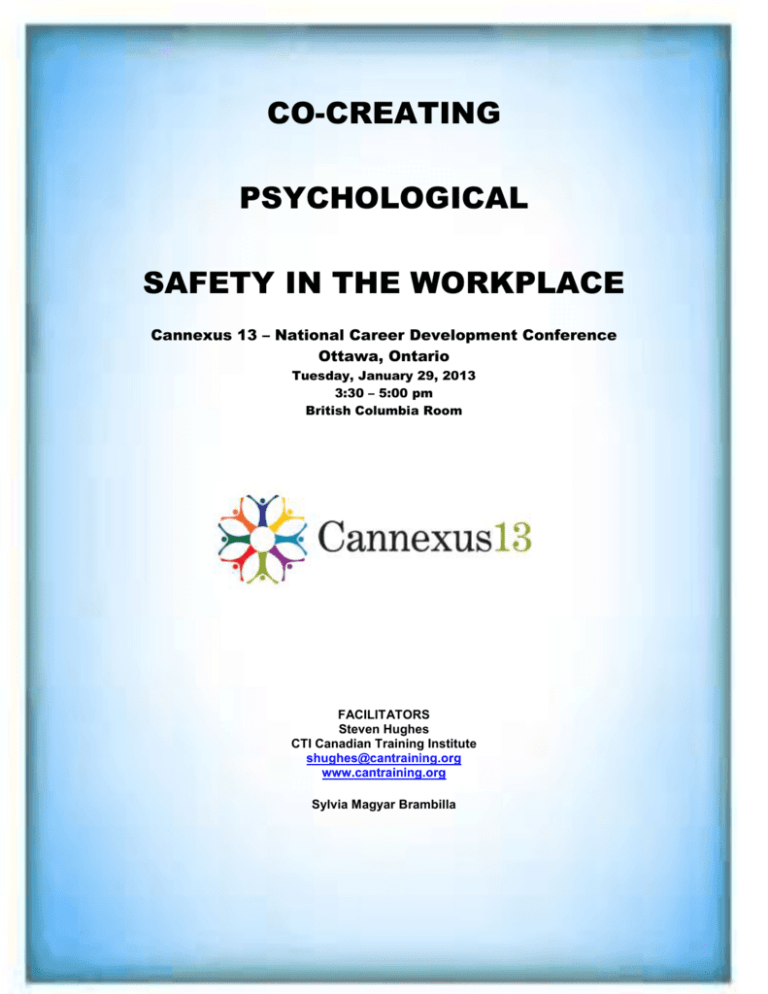
CO-CREATING PSYCHOLOGICAL SAFETY IN THE WORKPLACE Cannexus 13 – National Career Development Conference Ottawa, Ontario Tuesday, January 29, 2013 3:30 – 5:00 pm British Columbia Room FACILITATORS Steven Hughes CTI Canadian Training Institute shughes@cantraining.org www.cantraining.org Sylvia Magyar Brambilla 0 OPENING CIRCLE Checking-in 1) What aspect of your work/life is currently consuming most of your time and energy? 2) What do you already know about the topic of psychological safety? What are you specifically hoping to learn today? 3) Share an experience where you felt a deep sense of community … 1 DEFINITIONS OF PSYCHOLOGICAL SAFETY “A psychologically safe and healthy workplace is one that promotes employees’ psychological well-being and does not harm employee health in negligent, reckless or intentional ways.” (from Guarding Minds @ Work) Psychological safety describes the individual’s perceptions about the consequences of interpersonal risk in their work environment. It consists of taken-for-granted beliefs about how others will respond when one puts oneself on the line, such as asking a question, seeking feedback, reporting a mistake, or proposing a new idea. One weighs each potential action against a particular interpersonal climate, as in, “If I do this here, will I be hurt, embarrassed or criticized?” An action that might be unthinkable in one work group can be readily taken in another, due to different beliefs about possible interpersonal consequences. Amy C. Edmondson “The ability to learn and move forward after failure is much more likely in organizational climates marked by psychological safety – a shared expectation, conveyed by the words and actions of leaders, that people will be commended for admitting or pointing out mistakes, rather than shunned.” Teresa Amabile & Steven Kramer “Safe space means that people experience acceptance as a given, which frees them to get on with the serious business of passionate, creative collaboration, spirited debate, and engaged execution of the organization’s vision.” Pamela Meyer “To create a psychologically safe environment requires a minimum that you establish trust, boundaries, and a sense of control in the team or social environment.” Robert J. Marshak “Psychological safety involves feeling able to show and employ one’s self without fear of negative consequences, status, or career.” William A. Kahn “What makes a space safe? To the extent people feel confident that what they say will not be used against them, that their confidences will not be broken, and that they will not be taken advantage of or abandoned in a difficult spot – then they will risk being open.” Tom Atlee “The need to be safe is even deeper than the need to love and be loved.” Abraham Maslow 2 JOURNAL NOTES CHECKING-IN CREATING MY INTERIOR RESOURCE THE REVIEW MEETING CIRCLE PROCESS THE “MISTAKE OF THE MONTH” RITUAL 3 FOR FURTHER READING Amabile, Teresa M. & Steven Kramer. (2011). The Progress Principle: Using Small Wins to Ignite Joy, Engagement, and Creativity at Work. Boston: Harvard Business Review Press. Argyris, Chris. (1990). Overcoming Organizational Defenses: Facilitating Organizational Learning. Needham Heights, MA: Allyn & Bacon. Baldwin, Christina & Ann Linnea. (2010). The Circle Way: A Leader in Every Chair. San Francisco: Berrett-Koehler Publishers, Inc. Block, Peter. (2008). Community: The Structure of Belonging. San Francisco: Berrett-Koehler Publishers, Inc. Bloom, Sandra. (1997). Creating Sanctuary: Toward the Evolution of Sane Societies. New York: Routledge . Covey, Stephen M.R. (2006). The Speed of Trust: The One Thing That Changes Everything. New York: Free Press. Edmondson, Amy C. (2012). Teaming: How Organizations Learn, Innovate, and Compete in the Knowledge Economy. San Francisco: Jossey-Bass. Egan, Gerard (1994). Working the Shadow Side: A Guide to Positive Behind-the-Scenes Management. San Francisco: Jossey-Bass Publishers. Gilbert, Merv & Dan Bilsker. (2012). Psychological Health and Safety: An Action Guide for Employers. Calgary: Mental Health Commission of Canada and the Centre for Applied Research in Mental Health and Addiction. Goleman, Daniel. (2006). Social Intelligence: The New Science of Social Relationships. New York: Bantam Books. Kabat-Zinn, Jon. (2005). Coming to Our Senses: Healing Ourselves and the World Through Mindfulness. New York: Hyperion. Kramer, R.M. & K.S. Cook (eds.).(2004). Trust and Distrust in Organizations. New York: Russell Sage Foundation. Marshak, Robert J. (2006). Covert Processes at Work: Managing the Five Hidden Dimensions of Organizational Change. San Francisco: Berrett-Koehler Publishers. McLain-Smith, Diana. (2011). Elephant in the Room: How Relationships Make or Break the Success of Leaders and Organizations. San Francisco: Jossey-Bass. Meyer, Pamela. (2010). From Workplace to Playspace: Innovating, Learning and Changing Through Dynamic Engagement. San Francisco: Jossey-Bass. Palmer, Parker J. (2004). A Hidden Wholeness: The Journey Toward An Undivided Life – Welcoming the Soul and Weaving Community in a Wounded World. San Francisco: Jossey-Bass. Reina, D.S. & Reina, M.L. (2006). Trust and Betrayal in the Workplace. San Francisco: Berrett-Koehler Publishers, Inc. 4 Richo, David. (1999). Shadow Dance: Liberating the Power and Creativity of Your Dark Side. Boston, MA: Shambhala Publications, Inc. Rock, David. (2009). Your Brain at Work: Strategies for Overcoming Distraction, Regaining Focus, and Work Smarter All Day Long. New York: Harper Business. Schön, Donald. (1983). The Reflective Practitioner: How Professionals Think in Action. New York: Basic Books. Shain, Martin & Mary Ann Baynton. (2011). Preventing Workplace Meltdown: An Employer’s Guide to Maintaining a Psychologically Safe Workplace. Toronto: Carswell. Shain, Martin. (2010). The Shain Reports on Psychological Safety in the Workplace – A Summary. Prepared for the Mental Health Commission of Canada. www.mentalhealthcommission.ca Starhawk. (2011). The Empowerment Manual: A Guide for Collaborative Groups. Gabriola Island, B.C.: New Society Publishers. Wheatley, Margaret J. (2002). Turning to One Another: Simple Conversations to Restore Hope to the Future. San Francisco: Berrett-Koehler Publishers, Inc. “Contemplate the workings of this world, listen to the words of the wise, and take all that is good as your own. With this as your base, open your own door to truth.” Morihei Ueshiba 5



